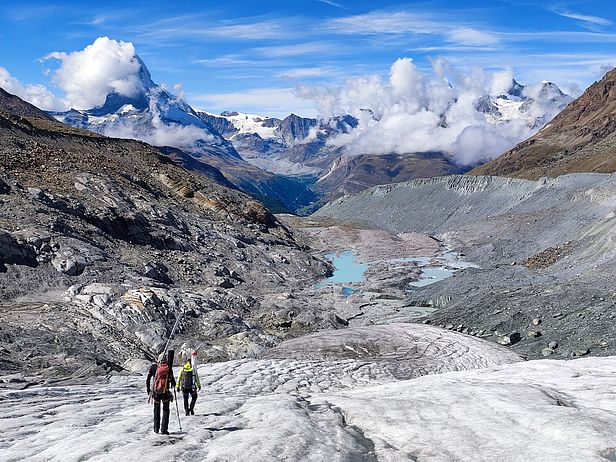With increasing temperatures, more heatwaves and less snowfall, glacier melt is accelerating. Whether we will still have water reserves in the form of frozen ice by 2100 depends heavily on efforts to contain the climate crisis.
The retreat of the glaciers is probably the most noticeable consequence of global warming. For a while, the meltwater will continue to fill the rivers in summer - but by the end of the 21st century, most of the ice in the Alps will have melted. Water will become scarcer, especially in summer, which will pose challenges for drinking water supplies and agriculture. The melting glaciers also increase the risk of natural hazard events. For example, there could be a temporary increase in glacial lake outbursts and ice avalanches. On a global scale, the melted ice flows into the oceans and contributes to rising sea levels and flooded coastal areas.
The glaciologists at WSL create important basic knowledge and contribute to preparing for these challenges with their work. They document long-term glacier changes in the Swiss Alps (GLAMOS monitoring network). They are analysing processes underneath the glacier (LEAD project) and forecasting water availability - both in Switzerland (FORHYCS-ICE project) and in countries with critical water resources, such as in the Himalayan region (ETERNALHIMA project). They are investigating new risks such as water pockets dammed under the ice that can cause sudden flood waves (DIWING project). WSL is working on these and other projects as part of the joint professorship with the Laboratory of Hydraulics, Hydrology and Glaciology (VAW) at ETH Zurich.

Glaciologists' research sheds light on the disappearance of the once eternal ice. In doing so, they look both into the past and into the future:
A look back: ¶
Glacier ice has been melting worldwide since the middle of the 20th century - and at an ever faster rate. In 2021, an international research team with the participation of WSL analysed the global extent of glacier melting for all 220,000 glaciers outside the Greenland and Antarctic ice sheets for the first time. The figures are unimaginable: between 2000 and 2019, glaciers worldwide lost an average of 267 billion tonnes of ice per year. This volume could have submerged the land area of Switzerland by six metres every year. The loss of mass has also accelerated significantly. Read more ...
Switzerland has also been severely affected by the melting of glaciers. Using historical photos, WSL researchers were able to reconstruct the glacier volume up to the 1930s. The comparison is sobering: by 2016, only half of the glacier volume was still present (see image comparison). And here, too, the process is accelerating. Most recently, the two extreme years of 2022 and 2023 destroyed ten per cent of the Swiss glacier volume. Read more ...
The outlook: ¶
How much glacier ice will survive until the end of this century depends on global efforts to contain the climate crisis. WSL researchers have modelled these scenarios. In a scenario with unchecked investment in fossil fuels, more than 40 per cent of the world's glacier volume will disappear by 2100, or more than 80 per cent of the number of glaciers relative to 2015. But even if emissions fall and the temperature rises by only +1.5°C compared to pre-industrial levels, a quarter of the ice volume and every second glacier worldwide will be lost. Read more ...
Model calculations for the Alps also show that the volume loss is heavily dependent on the expected temperature increase. If the temperature increase can be limited to 1.5°C compared to pre-industrial times, Alpine glaciers could stabilise at around a third of their current volume. Read more ...
The melting of glaciers is also accompanied by rapid, ongoing ecological change. This is because glacier retreat exposes large areas. According to a WSL study, up to 2100 new ecosystems will be created on these glacier forefields worldwide, which will provide a refuge for cold-loving plant and animal species - and should be protected accordingly. Read more ...
More research on glaciers: ¶
Always up to date: Subscribe to the WSL Newsletter
Contact ¶
Links and documents ¶
- WSL research group Glaciology
- Laboratory of Hydraulics, Hydrology and Glaciology of the ETH Zurich
- Switzerland and climate change
News:
- 02.11.2023, WSL: Spending the night on a glacier
- 28.09.2023, SCNAT: Two catastrophic years obliterate 10% of Swiss glacier volume
- 16.08.2023, WSL: Global warming-induced glacier retreat could create novel ecosystems
- 17.02.2023, Potsdam Institute for Climate Impact Research: Earlier, higher, smaller: Climate change alters glacial lake outburst floods
- 06.01.2023, WSL: Two of three glaciers worldwide could disappear by 2100
- 22.08.2022, ETH Zürich: A historical perspective on glacial retreat
- 17.5.21, WSL: The fate of many Asian glaciers is sealed
- 29.4.21, WSL: Global glacier retreat has accelerated
- 05.08.20, WSL: Blanket of rock debris protects glaciers from climate change
- 09.04.2019, WSL: One third of alpine glaciers could be saved
- 12.02.2019, ETH Zürich and WSL: Ice volume of glaciers worldwide calculated anew
Publications ¶
Global ice volume ¶
Previous glacier melt ¶
Projections up to 2100 ¶
Glacier forefields ¶
Copyright ¶
WSL and SLF provide image and sound material free of charge for use in the context of press contributions in connection with this media release. The transfer of this material to image, sound and/or video databases and the sale of the material by third parties are not permitted.
